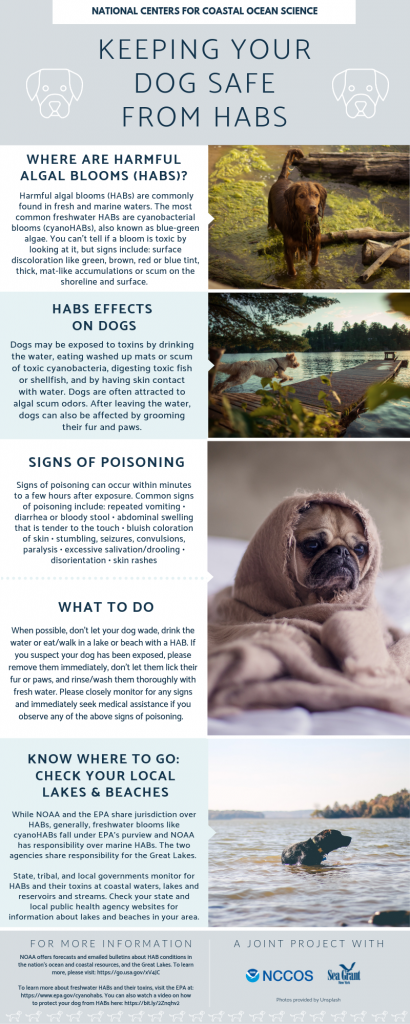
HAB 101: Harmful algal blooms — commonly called HABs — are found in every state in the U.S., and their occurrence is on the rise. The most common freshwater HABs are cyanobacterial blooms (cyanoHABs), also known as blue-green algae. CyanoHABs produce multiple toxins, including liver, nerve, and skin toxins, which can affect human and animal health. The most common HAB toxins in the U.S. are microcystins, a group of liver toxins that can cause gastrointestinal illness in humans, and mortality in pets, livestock, and wildlife. CyanoHABs occur naturally, but human activities like nutrient pollution, introduced species, and water flow modifications play a role in their more frequent occurrence and intensity.
Resources on HABs and Dogs: NCCOS funded New York Sea Grant to produce the Dogs and Harmful Algal Blooms brochure, which provides information on how dogs can be exposed to HAB toxins, dog symptoms that may follow exposure, and how to reduce your dog’s risk of exposure. Other resources on this topic include the Environmental Protection Agency’s video Protect your pooch from harmful algal blooms and the Center for Disease Control’s Reference Brochure for Veterinarians.
CyAN — An App that Shows HABs in Freshwater Lakes: The Cyanobacteria Assessment Network mobile application, or CyAN app, shows the location of cyanoHABs in over 2,000 of the largest lakes and reservoirs across the United States. While it was created to help local water quality managers and public health officials make decisions about recreational and drinking water safety related to cyanobacteria, it can be used by fishermen, boaters, tourists, and lake-side communities to plan trips, and by ranchers and pet owners to keep pets and livestock away from potentially toxic waters. The CyAN app was developed by the Environmental Protection Agency (EPA) in partnership with NOAA, the United States Geological Survey, and the National Aeronautics and Space Administration.
Federal Legislation and NOAA’s Role: Congress passed the Harmful Algal Bloom and Hypoxia Research and Control Act (HABHRCA) in 1998 and most recently reauthorized the Act in 2018. HABHRCA designates NOAA as the lead federal agency responsible for advancing our country’s ability to detect, monitor, assess, and forecast HAB and hypoxia events in coastal marine waters. NOAA and EPA share jurisdiction for the Great Lakes, and EPA has jurisdiction over activities that occur in inland freshwater areas other than the Great Lakes. NOAA supports EPA and other federal agencies in addressing freshwater HABs outside the Great Lakes by providing satellite imagery of blooms and partnering to develop tools for detection, forecasting, and mitigation.
For additional information on HABs, contact Quay Dortch (Quay.Dortch@noaa.gov).
To learn more about NCCOS research on coastal HABS, please visit the following webpages on the NCCOS website:
